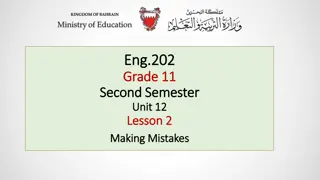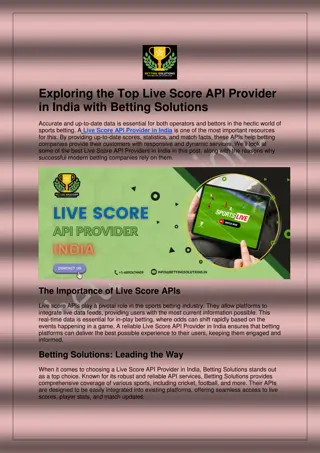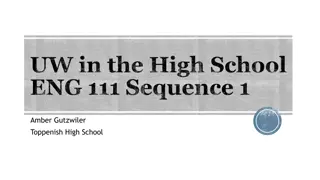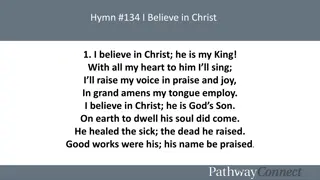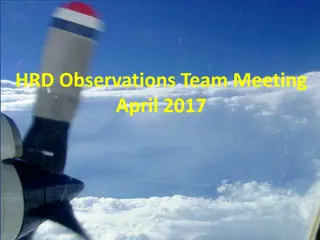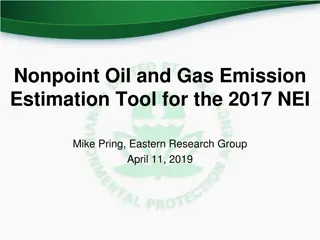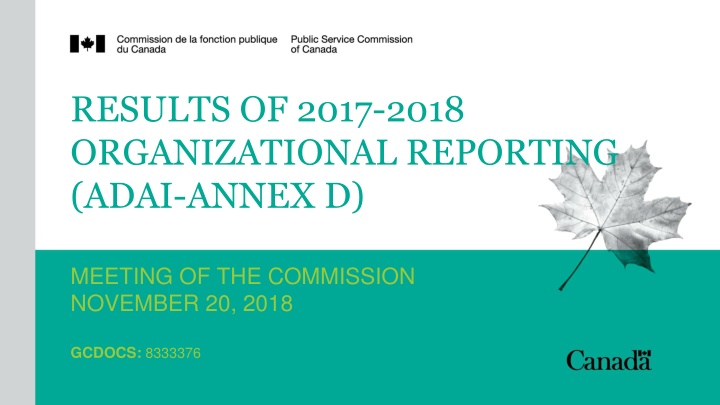
Key Results of 2017-2018 Organizational Reporting Meeting
Explore the outcomes from the 2017-2018 organizational reporting meeting, including exceptions to the national area of selection, internal investigations, and more. Gain insights into the trends and observations in organizational reporting for the year.
Download Presentation

Please find below an Image/Link to download the presentation.
The content on the website is provided AS IS for your information and personal use only. It may not be sold, licensed, or shared on other websites without obtaining consent from the author. If you encounter any issues during the download, it is possible that the publisher has removed the file from their server.
You are allowed to download the files provided on this website for personal or commercial use, subject to the condition that they are used lawfully. All files are the property of their respective owners.
The content on the website is provided AS IS for your information and personal use only. It may not be sold, licensed, or shared on other websites without obtaining consent from the author.
E N D
Presentation Transcript
RESULTS OF 2017-2018 ORGANIZATIONAL REPORTING (ADAI-ANNEX D) MEETING OF THE COMMISSION NOVEMBER 20, 2018 GCDOCS: 8333376
OBJECTIVES To provide an overview of the organizational reporting results stemming from Annex D of the Appointment Delegation and Accountability Instrument (ADAI) for year 2 and convey early trend indicators (if any). This includes: Results on exceptions to national area of selection approved by deputy heads (DH). Results for internal investigations conducted by DH under subsection 15(3) of the Public Service Employment Act (PSEA). Use of the Public Service Official Languages Exclusion Approval Order (PSOLEAO) and the Public Service Official Languages Appointment Regulations (PSOLAR). Results on the Public Service Commission (PSC) transition measure for second languages evaluation (SLE). An update on cyclical assessment results received to date. 2
RESULTS FOR EXCEPTIONS TO NATIONAL AREA OF SELECTION (NAOS) CONTEXT In 2008, the PSC implemented an NAOS requirement for jobs open to the public, with a provision that deputy heads request an exception to this requirement from the PSC, on a case by case basis. Five requests were received from 2008 to March 2016, and all were approved. In April 2016, the revised Appointment Policy maintained NAOS and gave DHs the authority to approve exceptions. The PSC therefore asked DHs to report annually on the use of this new discretion. Year # Exceptions (Processes) # Appointments # Orgs 2016-17 17 *49 8 2017-18 43 17 6 * Of 49 appointments, 31 were reported in 2017-18 for exceptions approved in 2016-17 In 2017-18, DH exceptions to NAOS accounted for 1.5% of all external advertised processes (43/2801). 3
RESULTS FOR EXCEPTIONS TO NAOS (contd) OBSERVATIONS TYPE OF POSITION LOCATION Entry Level Other Regions Headquarters Rationales included: sufficient pool of candidates (indicated for 10 exceptions), urgency, business needs and operational requirements (e.g. G7 summit in June 2018, staffing positions in the north and rural areas) CR-04 CR-05 PO-01 CS-01 58% RCMP 28% 30% 70% 72% 12% OGD s RECOMMENDATION Continue to gather information about the appointments and the various factors contributing to the exceptions, and examine the data to provide insight and gain knowledge about other emerging issues. 4
RESULTS OF INTERNAL INVESTIGATIONS CONTEXT Since the new ADAI came into effect, deputy heads must report to the PSC the results of any internal investigation undertaken during the fiscal year. OBSERVATIONS Fisheries and Oceans Canada and Infrastructure Canada are the only organizations that reported conducting internal investigations under subsection 15(3) of the PSEA (2 cases): One was founded; the corrective action taken was to re-assess the candidate. The other was unfounded but the organization decided to put a corrective measure in place by adding a requirement in the staffing checklist to review the translation of documents. 5
RESULTS OF INTERNAL INVESTIGATIONS (cont d) OBSERVATIONS (CONT D) While DHs can conduct internal investigations under subsection 15(3) of the PSEA, they can also decide to ask the PSC to conduct investigations on their behalf under subsection 67(2) of the PSEA. Year # Organizations Internal Investigations 15(3) PSC Investigations for DH 67(2) 2016-2017 1 3 2 2017-2018 2 2 10 RECOMMENDATION Continue to partner with organizations via outreach and annual liaison meeting. 6
RESULTS ON THE USE OF THE PSOLEAO AND THE PSOLAR CONTEXT There are 3 situations where people may be excluded from meeting the required level of proficiency in their second official language, following non-imperative appointments. When the individual: 1. 2. 3. Submits an agreement to become bilingual; Is eligible for an immediate annuity; or Is excluded for medical reasons. DHs must report on the first 2 exclusions. As the PSC is responsible for approving exclusions for medical reasons, there is no need for organizations to report on the 3rdone. The reporting cycle and elements on which the organizations must report remained the same as for previous years. Exclusions that are not compliant with the PSOLEAO and PSOLAR do not respect merit in regard to official language proficiency. 7
RESULTS ON THE USE OF THE PSOLEAO AND PSOLAR (cont d) OBSERVATIONS In 2017-2018, 38 of the 74 organizations reported using the PSOLEAO and PSOLAR. 35 organizations reported managing the exclusions in compliance with the instruments. A total of 4 cases are non-compliant, in 3 organizations. 2 cases where the exemption period was not extended beyond the 2-year initial period are now compliant. The 2 extensions have been approved as of April 18, 2018. 2 cases where exemptions exceeded the regulated 4-year maximum period to become bilingual. The majority of organizations manage the exclusions in accordance with the statutory instruments. RECOMMENDATION Policy Directorate (PD) and Staffing Support Division (SSD) work in collaboration with organizations to resolve non-compliant cases. 8
RESULTS ON THE PSCS TRANSITION MEASURE FOR SLE CONTEXT Between 2012 - 2015, the PSC implemented a transition measure for alternating employees and for employees with a surplus or lay-off priority entitlement: SLE results that were expired were deemed valid, subject to confirmation within 12 months of the alternation or priority appointment. This measure was used 501 times. DHs report on the use of this measure until their respective cases are resolved. OBSERVATIONS 8 cases outstanding in 7 organizations to be resolved on April 1, 2018 compared to 12 cases in 10 organizations last fiscal year: 4 cases were non-compliant. 1 case has now been resolved as of August 29, 2018. The remaining 4 cases are on extended leave and the computing of the 12-month period was suspended. RECOMMENDATION The PD and the SSD to continue working with organizations that have outstanding and non-compliant cases until all cases are resolved. 9
CYCLICAL ASSESSMENTS - UPDATE Since the implementation of the NDS, 8% (6/76) of organisations have submitted their cyclical assessment reports. They are: Organization Cycle received Canadian Intergovernmental Conference Secretariat 2016-2017 Indigenous and Northern Affairs Canada 2016-2017 Shared Services Canada* 2016-2017 Privy Council Office* 2017-2018 Natural Resources Canada 2017-2018 Public Safety Canada 2017-2018 The analysis of these reports is ongoing, and will be presented to EMC and MOC in the near future. _________________________________ *Requested by PSC 10
OVERALL OBSERVATIONS No significant trend markers can be identified at this time. The number of appointments made from DH approved exceptions to NAOS remains low. There is no significant change in terms of the number of internal investigations conducted by DH (15(3) of the PSEA) from the previous cycle reporting. Similar to last year, the majority of organizations manage the exclusions for PSOLEAO in accordance with the statutory instruments. 11



